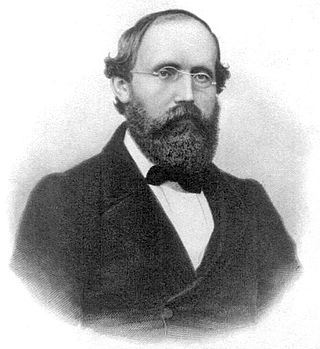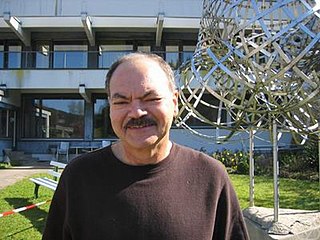Related Research Articles

Georg Friedrich Bernhard Riemann was a German mathematician who made profound contributions to analysis, number theory, and differential geometry. In the field of real analysis, he is mostly known for the first rigorous formulation of the integral, the Riemann integral, and his work on Fourier series. His contributions to complex analysis include most notably the introduction of Riemann surfaces, breaking new ground in a natural, geometric treatment of complex analysis. His 1859 paper on the prime-counting function, containing the original statement of the Riemann hypothesis, is regarded as a foundational paper of analytic number theory. Through his pioneering contributions to differential geometry, Riemann laid the foundations of the mathematics of general relativity. He is considered by many to be one of the greatest mathematicians of all time.

Lars Valerian Ahlfors was a Finnish mathematician, remembered for his work in the field of Riemann surfaces and his textbook on complex analysis.

Paul Julius Oswald Teichmüller was a German mathematician who made contributions to complex analysis. He introduced quasiconformal mappings and differential geometric methods into the study of Riemann surfaces. Teichmüller spaces are named after him.

Shing-Tung Yau is a Chinese-American mathematician. He is the director of the Yau Mathematical Sciences Center at Tsinghua University and Professor Emeritus at Harvard University. Until 2022, Yau was the William Caspar Graustein Professor of Mathematics at Harvard, at which point he moved to Tsinghua.

Serge Lang was a French-American mathematician and activist who taught at Yale University for most of his career. He is known for his work in number theory and for his mathematics textbooks, including the influential Algebra. He received the Frank Nelson Cole Prize in 1960 and was a member of the Bourbaki group.
Jürgen Kurt Moser was a German-American mathematician, honored for work spanning over four decades, including Hamiltonian dynamical systems and partial differential equations.
In mathematics, Carathéodory's theorem is a theorem in complex analysis, named after Constantin Carathéodory, which extends the Riemann mapping theorem. The theorem, published by Carathéodory in 1913, states that any conformal mapping sending the unit disk to some region in the complex plane bounded by a Jordan curve extends continuously to a homeomorphism from the unit circle onto the Jordan curve. The result is one of Carathéodory's results on prime ends and the boundary behaviour of univalent holomorphic functions.
Arthur John "Jack" Lohwater was an American mathematician.

In mathematics, the Schwarz alternating method or alternating process is an iterative method introduced in 1869–1870 by Hermann Schwarz in the theory of conformal mapping. Given two overlapping regions in the complex plane in each of which the Dirichlet problem could be solved, Schwarz described an iterative method for solving the Dirichlet problem in their union, provided their intersection was suitably well behaved. This was one of several constructive techniques of conformal mapping developed by Schwarz as a contribution to the problem of uniformization, posed by Riemann in the 1850s and first resolved rigorously by Koebe and Poincaré in 1907. It furnished a scheme for uniformizing the union of two regions knowing how to uniformize each of them separately, provided their intersection was topologically a disk or an annulus. From 1870 onwards Carl Neumann also contributed to this theory.
James W. Cannon is an American mathematician working in the areas of low-dimensional topology and geometric group theory. He was an Orson Pratt Professor of Mathematics at Brigham Young University.
In mathematics, the Schoenflies problem or Schoenflies theorem, of geometric topology is a sharpening of the Jordan curve theorem by Arthur Schoenflies. For Jordan curves in the plane it is often referred to as the Jordan–Schoenflies theorem.
In mathematics, the conformal radius is a way to measure the size of a simply connected planar domain D viewed from a point z in it. As opposed to notions using Euclidean distance, this notion is well-suited to use in complex analysis, in particular in conformal maps and conformal geometry.
In mathematics, a quasicircle is a Jordan curve in the complex plane that is the image of a circle under a quasiconformal mapping of the plane onto itself. Originally introduced independently by Pfluger (1961) and Tienari (1962), in the older literature they were referred to as quasiconformal curves, a terminology which also applied to arcs. In complex analysis and geometric function theory, quasicircles play a fundamental role in the description of the universal Teichmüller space, through quasisymmetric homeomorphisms of the circle. Quasicircles also play an important role in complex dynamical systems.

Jürgen Jost is a German mathematician specializing in geometry. He has been a director of the Max Planck Institute for Mathematics in the Sciences in Leipzig since 1996.
Maurice Haskell Heins was an American mathematician, specializing in complex analysis and harmonic analysis.
In mathematics, Janiszewski's theorem, named after the Polish mathematician Zygmunt Janiszewski, is a result concerning the topology of the plane or extended plane. It states that if A and B are closed subsets of the extended plane with connected intersection, then any two points that can be connected by paths avoiding either A or B can be connected by a path avoiding both of them. The theorem has been used as a tool for proving the Jordan curve theorem and in complex function theory.
Nikolai Georgievich Makarov is a Russian mathematician. He is known for his work in complex analysis and its applications to dynamical systems, probability theory and mathematical physics. He is currently the Richard Merkin Distinguished Professor of Mathematics at Caltech, where he has been teaching since 1991.

Edward Barry Saff is an American mathematician, specializing in complex analysis, approximation theory, numerical analysis, and potential theory.
John "Jack" Marshall Lee is an American mathematician and professor at the University of Washington specializing in differential geometry.

Christian Lubich is an Austrian mathematician, specializing in numerical analysis.
References
- ↑ Christian Pommerenke at the Mathematics Genealogy Project
- ↑ biography Archived 2007-08-09 at the Wayback Machine from tu-berlin.de